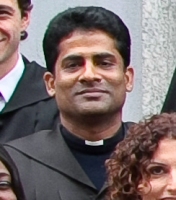Father Simon, Faith in Indian Healthcare
 |
|
The day of graduation |
When he received his Bocconi Master in Healthcare Management, Economics and Policy (MIHMEP) diploma on 7 February, Simon Pallupetta's academic gown made it look as if he were taking holy orders because it was worn over a clerical collar. A 40-year-old Catholic priest, Father Simon is originally from Kerala inSouthern India, an area where Catholics make up 20% of the population and live peacefully with the Hindu majority. When the Portuguese began the evangelization of the region towards the end of the 15th century, they were surprised by the Christian community dating back to Thomas the Apostle's preachings in the 1st century.
Homeland of the ayurveda and home to efficient rehabilitation structures, Kerala is becoming a destination for American healthcare tourism, due to its much lower costs. "The influx of rich clients, however," explains Father Simon, "makes prices go up and the less wealthy risk being excluded by an almost entirely private healthcare system. Among the few places that try to avoid these distortions is the Church."
The Archbishop of Ernakulam-Angamaly, where Father Simon is from, manages two hospitals of around 900 beds each, where around 10 priests and 150 nuns work. "Any kind of patient is welcome there and payment is adjusted to the individual's ability to pay," says Pallupetta. After several experiences managing social and healthcare programs at a local level, the Archbishop selected Father Simon for a management role in the hospitals and, in 2005, sent him to Italy to complete his education in the sector.
Italy proved to be different from his expectations. "The image, as the home of the Vatican, is that of a spiritual and religious country, a true point of reference for Catholics," says Father Simon, "and instead in Kerala there is much more religious spirit among followers of all doctrines. Among Catholics, 94% actually practice. In addition,Europe is idealized and therefore one doesn't expect to find so many social problems, poverty and unemployment. And, next to material well-being, one does not expect so much spiritual malaise."
Father Simon, who began his Italian pastoral activities in Pofi (in theProvince ofFrosinone, near Rome), discovered the MIHMEP during a visit to Paderno Dugnano (near Milan), where an assistant parish priest, Father Giuseppe Cotugno, was a Bocconi alum and knew about the Master. "One of the reasons I chose this opportunity instead of an alternative in Rome," explains Father Simon, "was the fact that it is taught in English." Pallupetta's class included 28 people from 18 different countries.
"I was able to participate in the Master thanks to a scholarship," he says, "and, after the program ended in June 2008, I stayed in touch with Elio Borgonovi and the CERGAS, which allowed me to conduct a study on patient satisfaction and quality. I try to get as much on-the-job experience as possible and during the Master I did an internship at the San Raffaele Hospital in Segrate, to see how things should work, and at the Little Flower Hospital in Angamali-India, one of my Archbishop's two hospitals, to begin to transfer some knowledge. At that time I was already planning two other experiences in Ireland and at Milan's Niguarda." Throughout all these experiences, he continued his pastoral activities for the communities of Dugnano and Incirano, two hamlets of Paderno Dugnano.
Father Simon will stay in Italyuntil 2010, before returning to Kerala as Assistant to the Director at one of the Archbishop's hospitals. "I would like to combine my work at the hospital with healthcare camps in the villages on the weekends, to encourage prevention, spread knowledge and support with the help of telemedicine. Today our structure already does 100 free cataract operations each week thanks to the support of a Canadian foundation. My great hope, however, is to be able to create a rehabilitation center for children with leukemia."